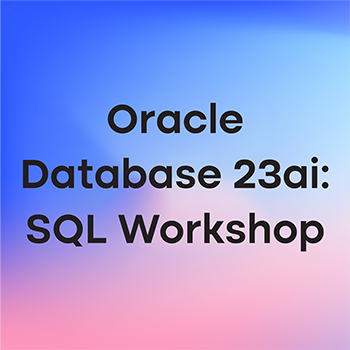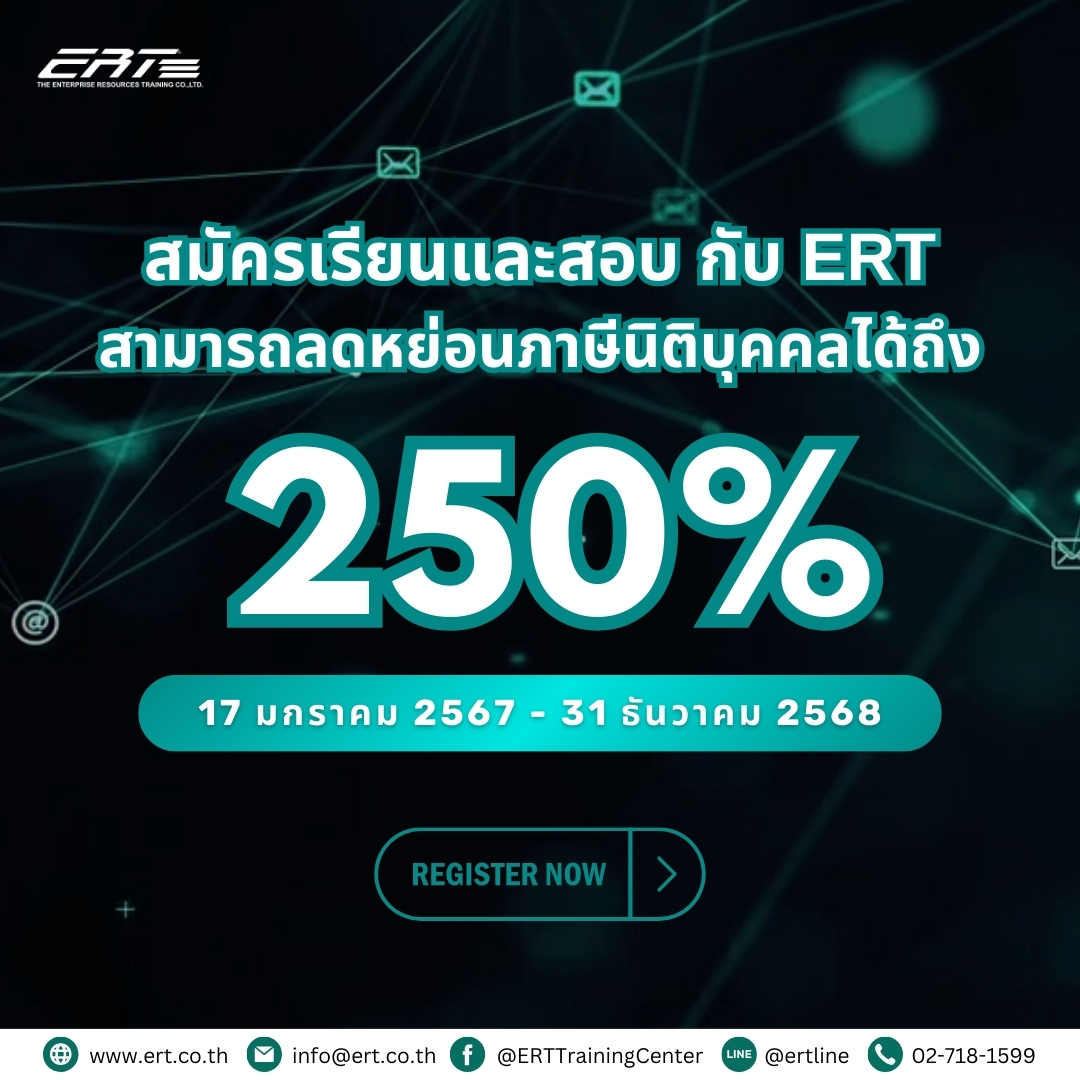Oracle Database 23ai: SQL Workshop
This course is targeted at Developers and Database Administrators and begins with the concepts of a relational database and the SQL programming language. It includes writing queries against single and multiple tables, manipulate data in tables, and create database objects. You’ll also learn how to create sequences, synonyms, indexes, and views, manage schema objects, and manage data using subqueries. Additionally, the course covers controlling User Access and managing data in different time zones.
STUDENTS WILL LEARN TO
- Retrieve Data using the SQL SELECT Statement
- Restrict and Sort Data
- Customize Output Using Single-Row Functions
- Use Conversion Functions and Conditional Expressions
- Report Aggregated Data Using the Group Functions
- Display Data from Multiple Tables Using Joins
- Manage Tables by Using DML Statements
- Create Sequences, Synonyms, Indexes, Views, and Schema Objects
- Manage Data by Using Subqueries and Advanced Queries
- Control User Access and Manage Data in Different Time Zones

|
Phone
|
Phone
|
|---|---|
|
Product
|
Oracle
|
|
Code
|
D1106069GC10
|
|
Duration
|
5 Days
|
|
Price (baht)
|
75,000
|
About the course
COURSE OUTLINE
MODULE 01 Course Overview
- Course Overview – Oracle Database 23ai: SQL Workshop
- Course Practice Environment: Security Credentials
MODULE 02 Oracle Database 23ai SQL Enhancements
- Oracle Database 23ai SQL New Features
- Returning clause of UPDATE and MERGE Statements, IF (NOT) EXISTS
MODULE 03 Introduction to SQL and Database Concepts
- Overview of Oracle Database 23ai and Related Products
- Overview of Relational Database Management Concepts and Terminologies
- Human Resources (HR) Schema and the Tables Used in This Course
- Introduction to SQL and Its Development Environments
- Oracle Database 23ai SQL Documentation and Additional Resources
- Practices for Lesson 1: Introduction
MODULE 04 Retrieving Data Using the SQL SELECT Statement
- Capabilities of SQL SELECT Statements
- Arithmetic Expressions and NULL Values in the SELECT statement
- Column Aliases
- Use of the Concatenation Operator, Literal Character Strings, Alternative Quote Operator, and the DISTINCT Keyword
- DESCRIBE Command
- Practices for Lesson 2: Retrieving Data Using the SQL SELECT Statement
MODULE 05 Restricting and Sorting Data
- Limiting Rows
- Rules of Precedence for Operators in an Expression
- Sorting Rows Using the ORDER BY Clause
- SQL Row Limiting Clause in a Query
- Substitution Variables in Oracle
- Assigning Values to Variables
- Practices for Lesson 3: Restricting and Sorting Data
MODULE 06 Using Single-Row Functions to Customize Output
- Single-Row SQL Functions
- Character Functions
- Nesting Functions
- Number Functions
- Working with Dates in Oracle Databases
- Date Functions
- Practices for Lesson 4: Using Single- Row Functions to Customize Output
MODULE 07 Using Conversion Functions and Conditional Expressions
- Implicit and Explicit Data Type Conversion
- TO_CHAR, TO_DATE, and TO_NUMBER Functions in Oracle
- General Functions
- Conditional Expressions
- Practices for Lesson 5: Using Conversion Functions and Conditional Expressions
MODULE 08 Reporting Aggregated Data Using the Group Functions
- JSON Functions
- Reporting Aggregated Data Using the Group Functions/Group Functions
- Grouping Rows
- Nesting Group Functions
- Practices for Lesson 6: Reporting Aggregated Data Using the Group Functions
MODULE 09 Displaying Data from Multiple Tables Using Joins
- Displaying Data from Multiple Tables Using Joins
- Natural Join
- Join with the USING Clause
- Join with the ON Clause
- Self-Join
- Nonequijoins
- Outer Join
- Cartesian Product
- Practices for Lesson 7: Displaying Data from Multiple Tables Using Joins
MODULE 10 Using Subqueries to Solve Queries
- Using Subqueries to Solve Queries
- Single-Row Subqueries
- Multiple-Row Subqueries
- Multiple-Column Subqueries
- Null Values in a Subquery
- Practices for Lesson 8: Using Subqueries to Solve Queries
MODULE 11 Using Set Operators
- Using Set Operators
- Tables Used in This Lesson
- UNION and UNION ALL Operators
- INTERSECT Operator
- MINUS Operator
- Matching SELECT Statements
- Using the ORDER BY Clause in Set Operations
- Practices for Lesson 9: Using Set Operators
MODULE 12 Manipulating Data
- Managing Tables Using DML Statements
- Changing Data in a Table
- Removing Rows from a Table
- Database Transaction Control
- Read Consistency
- Manual Data Locking
- Practices for Lesson 10: Manipulating Data
MODULE 13 Introduction to Data Definition Language
- Introduction to Data Definition Language
- CREATE TABLE Statement
- Data Types
- Constraints: Overview
- Creating a Table by Using a Subquery
- ALTER TABLE Statement
- DROP TABLE Statement
- Practices for Lesson 11: Introduction to Data Definition Language
MODULE 14 Introduction to Data Dictionary Views
- Introduction to Data Dictionary
- Querying the Dictionary Views
- Adding a Comment to a Table and Querying the Dictionary Views
- Practices for Lesson 12: Introduction to Data Dictionary Views
MODULE 15 Creating Sequences, Synonyms, and Indexes
- Create, Maintain, and Use Sequences
- Create Private and Public Synonyms
- Create and Maintain Indexes
- Practices for Lesson 13: Creating Sequences, Synonyms, and Indexes
MODULE 16 Creating Views
- Creating Views
- Creating, Modifying, and Retrieving Data from a View
- Data Manipulation Language (DML) Operations on a View
- Dropping a View
- Practices for Lesson 14: Creating Views
MODULE 17 Managing Schema Objects
- Managing Schema Objects
- Create and Use Temporary Tables
- Creating and Using External Tables
- Practices for Lesson 15: Managing Schema Objects
MODULE 18 Retrieving Data Using Subqueries
- Retrieving Data by Using a Subquery as a Source
- Writing a Multiple-Column Subquery
- Using Scalar Subqueries in SQL
- Solving Problems with Correlated Subqueries
- Using the EXISTS and NOT EXISTS Operators
- Using the WITH Clause
- Practices for Lesson 16: Retrieving Data Using Subqueries
MODULE 19 Manipulating Data Using Subqueries
- Manipulating Data by Using Subqueries
- Inserting Values by Using a Subquery as a Target
- Using the WITH CHECK OPTION keyword on DML statements
- Using Correlated Subqueries to Update and Delete Rows
- Practices for Lesson 17: Manipulating Data Using Subqueries
MODULE 20 Controlling User Access
- Controlling User Access
- Creating a Role
- Object Privileges
- Revoking Object Privileges
- Practices for Lesson 18: Controlling User Access
MODULE 21 Manipulating Data Using Advanced Queries
- Manipulating Data Using Advanced Queries
- Multitable INSERTS
- Merging Rows in a Table
- Performing Flashback Operations
- Tracking the Changes in Data Over a Period of Time
- Practices for Lesson 19: Manipulating Data Using Advanced Queries
MODULE 22 Managing Data in Different Time Zones
- Managing Data in Different Time Zones
- INTERVAL Data Types
- Aggregation over INTERVAL types
- Additional Date Functions
- SYSDATE and SYSTIMESTAMP Data Handling
- Practices for Lesson 20: Managing Data in Different Time Zones
MODULE 23 Appendix A Through J
- Appendix A Through J Overview
- Practices for Appendix A Through J: Additional Practices and Solutions
Register for Training
Schedule
| Start Date | End Date | Duration (days) | Price | Register | Course | Code | Product |
|---|

